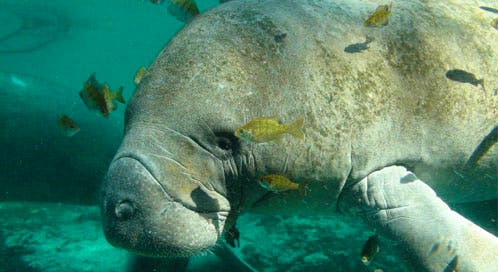It’s Manatee Awareness Month – a time to celebrate the gentle giants that are our official state marine mammal here in Florida. Relatives of the elephant, manatees spend a lot of time grazing on seagrasses in shallow water, and are sometimes referred to as sea cows. Because Florida manatees are an endangered species, it’s especially important that people know more about these wonderful animals and what we can do to protect them.

© David Hinkel/USFWS
Sadly, as we reported this spring, this has been a particularly brutal year for manatees. In fact, 2013 is now the deadliest year on record for the number of manatees killed: a total of 771 manatees as of November 5, 2013 and we still have nearly two months to go.
What made 2013 so deadly? It was due in large part to two unusual algal blooms, one on each coast. The toxic red tide bloom on the Gulf coast killed many manatees directly, while the “brown tide” in the Indian River Lagoon killed off much of their food supply. These two unprecedented events, coupled with the usual threats manatees encounter every year – especially injuries from watercraft – have dealt a significant loss to the population, estimated at around 5,000 animals.
With winter approaching, and so many manatees lost already, it’s more important than ever that they find safe, warm water in which to spend the next few months. The greatest long-term threat to manatees involves the loss of warm-water habitat that they need to survive. Manatees become susceptible to cold stress when water temperatures dip below 68 degrees Fahrenheit. Because residential development has greatly reduced the natural warm-water springs used by manatees, many of the animals aggregate in the outfalls at electric power plants on cold winter days. A significant number of manatees could be lost in the next few decades if natural areas are not available to manatees as aging plants are shut down or experience equipment failure.
To help make traveling to and within warmer waters safer for manatees, a number of seasonal manatee slower-speed protection zones go into effect on November 15 throughout the state. Boaters can help these slow-moving animals by reducing their speed and being alert to the presence of manatees, such as seeing a snout, tail or a large swirl on the surface of the water. Obeying posted speed zones, wearing polarized sunglasses and watching out for manatees can all help save their lives.
There are also other ways that everyone, whether you live and boat in Florida or not, can help manatees. You can visit our website to learn more about these fascinating marine mammals, and share what you know with family and friends; conservation starts with awareness! You can also help by supporting programs that strengthen the Endangered Species Act, which has been vital to manatees’ survival, and Everglades restoration, which will be extremely important to their future. And of course, you can help by supporting Defenders’ efforts. We work to conserve and recover the Florida manatee by protecting habitat, reducing watercraft strikes, improving coastal policies and increasing enforcement of those policies. We advocate for officials and state wildlife agencies to preserve and restore natural springs, conserve seagrass habitat, expand protected areas, designate and enforce protective speed zones and safeguard state and federal policies that protect manatees.
Elizabeth Fleming is Defenders’ Florida Representative





